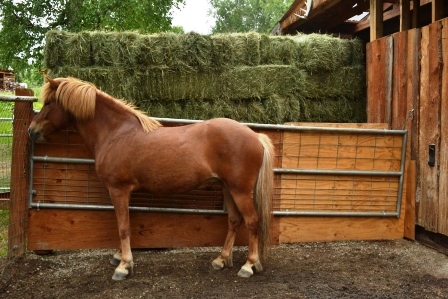
Home > Dispatches > Daily Dispatches 2014 > Daily Dispatch #167
June 18, 2014: Hay Days
Now waiting, waiting, for the first local cutting of hay to materialize. I will breathe easier once the load is in the barn. This cutting is later this year than other years because it’s been dry, cold, overcast. In a good year our three haysheds would already be full. Instead, we are now purchasing out-of-state hay at the local feed stores/tack shops. The hay in Palmer, purchased at Animal Food Warehouse, cost-wise, more pricey than the hay in Anchorage, purchased at M bar D, or Alaska Mill and Feed. So we’ve been driving to Anchorage to pick up (on an average) ten compressed bales at a time. |
|
| The horses really like the out-of-state hay. But then they like the in-state hay. Icelandic horses are easy to please food-wise. In state, out-of-state, if its dust and mold free and not overly stemmy they will gobble it down. Someone once observed that Icelandic horses aren’t good plow horses because they have a tendency to stop work and chow down. Hay prices are high here in Alaska. Good local hay costs upwards of $12.00 a bale out of the barn. This is compared to out-of-state hay which costs upwards of $21.00 a bale. I (of course) in feeding both, make sure that there is no wasteage. What’s left on the ground by the hitching post ends up in the compost facility – and this amount is miniscule. For us, buying out-of-state hay is an absolute last resort. This is in part because it’s so costly. But at the same time, purchasing and feeding out-of-state hay is a very unsustainable practice. It is “harvested” in the Lower-48, and then brought here by semi. The vehicles don’t run on biodiesel. Rather, they run on oil and gas, both non-renewable resources. And, of course, the vehicles travel on roads, which require vehicular maintenance. And, in addition, they contribute to air pollution. Our horses need hay. Don’t have enough lawn fodder to sustain them. So what are we to do? This past year we got back from our trip on October 1. Our local supplier had enough on hand to feed our then herd of four. But it wasn’t quite enough. We ended up having to rely on the not-so-good high cost/non sustainability alternative. One option might be to part with all the horses. The other might be to reduce our herd size. So who would we part with? Tinni, our old gelding and steady eddy horse, Hrimfara, our young filly and up and coming star, or Raudi, our middle aged mare and now experienced riding horse? You tell me. In either case, someone else would be faced with the same problem. So for now, the horses are getting the primo stuff, and we are waiting, waiting, waiting for our local supplier to begin cutting. When he does, we’ll be the first in a very long line of horse owners, most of whom are also dealing with the ins and outs of the cost/sustainability dilemma. Next: 168. 6/19/14: Horse Training: Moving Forward on the Home Front |
|
